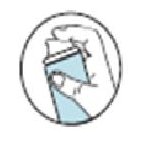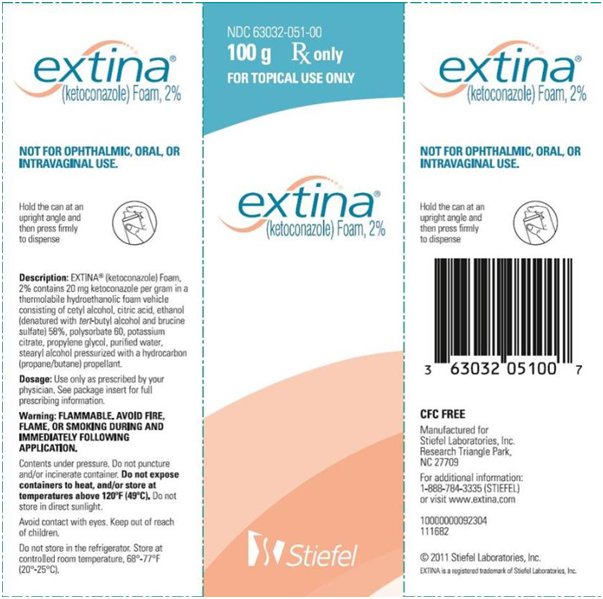EXTINA- ketoconazole aerosol, foam
Stiefel Laboratories Inc
----------
HIGHLIGHTS OF PRESCRIBING INFORMATIONThese highlights do not include all the information needed to use EXTINA® Foam safely and effectively. See full prescribing information for EXTINA® Foam.
EXTINA® (ketoconazole) Foam, 2% For topical use only Initial U.S. Approval: 1981 INDICATIONS AND USAGEEXTINA® Foam is indicated for topical treatment of seborrheic dermatitis in immunocompetent patients 12 years of age and older (1). Safety and efficacy of EXTINA® Foam for treatment of fungal infections have not been established. DOSAGE AND ADMINISTRATIONDOSAGE FORMS AND STRENGTHSEXTINA® Foam contains 2% ketoconazole in a thermolabile hydroethanolic foam in 50 g and 100 g containers (3). CONTRAINDICATIONSNone (4) WARNINGS AND PRECAUTIONSADVERSE REACTIONSThe most common adverse reactions observed in clinical studies (incidence > 1%) were application site burning and application site reaction (6.1). To report SUSPECTED ADVERSE REACTIONS, contact Stiefel Laboratories, Inc. at 1-888-784-3335 (STIEFEL) or adverse.event@stiefel.com and FDA at 1-800-FDA-1088 or www.fda.gov/medwatch. See 17 for PATIENT COUNSELING INFORMATION and FDA-approved patient labeling. Revised: 9/2012 |
FULL PRESCRIBING INFORMATION
1 INDICATIONS AND USAGE
EXTINA® (ketoconazole) Foam, 2% is indicated for the topical treatment of seborrheic dermatitis in immunocompetent patients 12 years of age and older. Safety and efficacy of EXTINA® Foam for treatment of fungal infections have not been established.
2 DOSAGE AND ADMINISTRATION
EXTINA® Foam should be applied to the affected area(s) twice daily for four weeks.
Hold the container upright, and dispense EXTINA® Foam into the cap of the can or other cool surface in an amount sufficient to cover the affected area(s). Dispensing directly onto hands is not recommended, as the foam will begin to melt immediately upon contact with warm skin. Pick up small amounts of EXTINA® Foam with the fingertips, and gently massage into the affected area(s) until the foam disappears. For hair-bearing areas, part the hair, so that EXTINA® Foam may be applied directly to the skin (rather than on the hair).
Avoid contact with the eyes and other mucous membranes. EXTINA® Foam is not for ophthalmic, oral or intravaginal use.
3 DOSAGE FORMS AND STRENGTHS
EXTINA® Foam contains 2% ketoconazole in a thermolabile hydroethanolic foam, and is provided in 50 g and 100 g aluminum containers.
5 WARNINGS AND PRECAUTIONS
5.1 Contact Sensitization
EXTINA® Foam may result in contact sensitization, including photoallergenicity. [See Adverse Reactions (6.2)]
5.2 Flammable Contents
The contents of EXTINA® Foam include alcohol and propane/butane, which are flammable. Avoid fire, flame and/or smoking during and immediately following application. Do not puncture and/or incinerate the containers. Do not expose containers to heat and/or store at temperatures above 120°F (49°C).
5.3 Systemic Effects
Hepatitis has been seen with orally administered ketoconazole (1:10,000 reported incidence). Lowered testosterone and ACTH–induced corticosteroid serum levels have been seen with high doses of orally administered ketoconazole. These effects have not been seen with topical ketoconazole.
6 ADVERSE REACTIONS
6.1 Adverse Reactions in Clinical Trials
Because clinical trials are conducted under widely varying conditions, adverse reaction rates observed in the clinical trials of a drug cannot be directly compared to rates in the clinical trials of another drug, and may not reflect the rates observed in practice. The adverse reaction information from clinical trials does, however, provide a basis for identifying the adverse reactions that appear to be related to drug use and for approximating rates.
The safety data presented in Table 1 (below) reflect exposure to EXTINA® Foam in 672 subjects, 12 years and older with seborrheic dermatitis. Subjects applied EXTINA® Foam or vehicle foam twice daily for 4 weeks to affected areas on the face, scalp, and/or chest. Adverse reactions occurring in > 1% of subjects are presented in
Table 1.
|
Adverse Reactions |
EXTINA® Foam
|
Vehicle Foam
|
|
Subjects with an
|
188 (28%) |
122 (25%) |
|
Application site burning |
67 (10%) |
49 (10%) |
|
Application site reaction |
41 (6%) |
24 (5%) |
Application site reactions that were reported in < 1% of subjects were dryness, erythema, irritation, paresthesia, pruritus, rash and warmth.
8 USE IN SPECIFIC POPULATIONS
8.1 Pregnancy
Teratogenic Effects, Pregnancy Category C
Ketoconazole has been shown to be teratogenic (syndactylia and oligodactylia) in the rat when given orally in the diet at 80 mg/kg/day (4.8 times the maximum expected human topical dose based on a mg/m2 comparison, assuming 100% absorption from 8 g of foam). However, these effects may be partly related to maternal toxicity, which was also observed at this dose level. [See Pharmacokinetics (12.3)]
No reproductive studies in animals have been performed with EXTINA® Foam. There are no adequate and well-controlled studies of EXTINA® Foam in pregnant women.
EXTINA® Foam should be used during pregnancy only if the potential benefit justifies the potential risk to the fetus.
8.3 Nursing Mothers
It is not known whether EXTINA® Foam administered topically could result in sufficient systemic absorption to produce detectable quantities in breast milk. Because many drugs are excreted in human milk, caution should be exercised when EXTINA® Foam is administered to women who are breastfeeding.
8.4 Pediatric Use
The safety and effectiveness of EXTINA® Foam in pediatric patients less than 12 years of age have not been established.
Of the 672 subjects treated with EXTINA® Foam in the clinical trials, 44 (7%) were from 12 to 17 years of age. [See Clinical Studies (14)]
11 DESCRIPTION
EXTINA® Foam contains 2% ketoconazole USP, an antifungal agent, in a thermolabile hydroethanolic foam for topical application.
The chemical name for ketoconazole is piperazine, 1-acetyl-4-[4-[[2-(2,4-dichlorophenyl) -2-(1H-imidazol-l-ylmethyl)-1,3-dioxolan-4-yl]methoxy]phenyl]-, cis- with the molecular formula C26H28Cl2N4O4 and a molecular weight of 531.43. The following is the chemical structure:
EXTINA® Foam contains 20 mg ketoconazole per gram in a thermolabile hydroethanolic foam vehicle consisting of cetyl alcohol, citric acid, ethanol (denatured with tert-butyl alcohol and brucine sulfate) 58%, polysorbate 60, potassium citrate, propylene glycol, purified water, and stearyl alcohol pressurized with a hydrocarbon (propane/butane) propellant.
12 CLINICAL PHARMACOLOGY
12.1 Mechanism of Action
The mechanism of action of ketoconazole in the treatment of seborrheic dermatitis is not known.
12.3 Pharmacokinetics
In a bioavailability study, 12 subjects with moderate to severe seborrheic dermatitis applied 3 g of EXTINA® Foam twice daily for 4 weeks. Circulating plasma levels of ketoconazole were < 6 ng/mL for a majority of subjects (75%), with a maximum level of 11 ng/mL observed in one subject.
13 NONCLINICAL TOXICOLOGY
13.1 Carcinogenesis, Mutagenesis, Impairment of Fertility
Long-term animal studies have not been performed to evaluate the carcinogenic or photo-carcinogenic potential of EXTINA® Foam.
In oral carcinogenicity studies in mice (18-months) and rats (24-months) at dose levels of 5, 20 and 80 mg/kg/day ketoconazole was not carcinogenic. The high dose in these studies was approximately 2.4 to 4.8 times the expected topical dose in humans based on a mg/m2 comparison. In a bacterial reverse mutation assay, ketoconazole did not express any mutagenic potential. In three in vivo assays (sister chromatid exchange in humans, dominant lethal and micronucleus tests in mice), ketoconazole did not exhibit any genotoxic potential.
At oral dose levels of 75 mg/kg/day (4.5 times the expected topical human dose in mg/m2), ketoconazole impaired reproductive performance and fertility when administered to male rats (increased abnormal sperm, decreased sperm mobility and decreased pregnancy in mated females).
14 CLINICAL STUDIES
The safety and efficacy of EXTINA® Foam were evaluated in a randomized, double-blind, vehicle-controlled study in subjects 12 years and older with mild to severe seborrheic dermatitis. In the study, 427 subjects received EXTINA® Foam and 420 subjects received vehicle foam. Subjects applied EXTINA® Foam or vehicle foam twice daily for 4 weeks to affected areas on the face, scalp, and/or chest. The overall disease severity in terms of erythema, scaling, and induration was assessed at Baseline and week 4 on a 5-point Investigator’s Static Global Assessment (ISGA) scale.
Treatment success was defined as achieving a Week 4 (end of treatment) ISGA score of 0 (clear) or 1 (majority of lesions have individual scores for scaling, erythema, and induration that averages 1 [minimal or faint]) and at least two grades of improvement from baseline. The results are presented in Table 2. The database was not large enough to assess whether there were differences in effects in age, gender, or race subgroups.
|
Number of Subjects |
EXTINA® Foam
|
Vehicle Foam
|
|
Subjects Achieving Treatment Success |
|
|
16 HOW SUPPLIED/STORAGE AND HANDLING
EXTINA® Foam, 2% is supplied in 50 g (NDC 63032-051-50) and 100 g (NDC 63032-051-00) aluminum containers.
Store at controlled room temperature 68° to 77°F (20° to 25°C). Do not store under refrigerated conditions. Do not expose containers to heat, and/or store at temperatures above 120°F (49°C). Do not store in direct sunlight.
Contents are flammable.
Contents under pressure. Do not puncture and/or incinerate container.
Keep out of reach of children.
17 PATIENT COUNSELING INFORMATION
See FDA-approved patient labeling. (17.3)
17.1 Instructions for Use
• Avoid fire, flame and/or smoking during and immediately following application.
• Do not apply EXTINA® Foam directly to hands. Dispense onto a cool surface, and apply to the affected areas using the fingertips.
17.2 Local Reactions
• EXTINA® Foam may cause skin irritation (application site burning and/or reactions)
• EXTINA® Foam may cause contact sensitization.
• As with any topical medication, patients should wash their hands after application.
• Inform a physician if the area of application shows signs of increased irritation and report any signs of adverse reactions.
PATIENT INFORMATION
EXTINA® (ex-TEEN-ah) Foam (ketoconazole, 2%)
IMPORTANT: For skin use only. Do not use in the eyes, mouth or vagina.
Read the Patient Information that comes with EXTINA® Foam before you start using it and each time you get a refill. There may be new information. This leaflet does not take the place of talking with your doctor about your condition or treatment.
What is EXTINA® Foam?
EXTINA® Foam is used on the skin (topical) to treat a skin condition called seborrheic dermatitis in patients 12 years and older. Seborrheic dermatitis can cause areas of flaky skin (scales) on the scalp, face, ears, chest or upper back.
EXTINA® Foam has not been studied in children less than 12 years old.
What should I tell my doctor before using EXTINA® Foam?
For female patients, tell your doctor if you:
• are pregnant or become pregnant. It is not known if EXTINA® Foam can harm a fetus (unborn baby).
• breastfeeding. It is not known if EXTINA® Foam passes into breast milk.
How should I use EXTINA® Foam?
• Apply EXTINA® Foam exactly as prescribed. EXTINA® Foam is usually applied to the affected skin areas two times a day (once in the morning and once at night) for 4 weeks. Talk to your doctor if your skin does not improve after 4 weeks of treatment with EXTINA® Foam.
• Keep the EXTINA® Foam can away from and do not spray it near fire, open flame, or direct heat. EXTINA® Foam is flammable. Never throw the EXTINA® Foam can into a fire, even if the can is empty.
Instructions for applying EXTINA® Foam
What are the possible side effects of EXTINA® Foam?
The most common side effects of EXTINA® Foam are reaction or burning on treated skin areas. Tell your doctor if you have any reaction on your treated skin such as redness, itching, or a rash. These are not all the side effects of EXTINA® Foam. Ask your doctor or pharmacist for more information.
How should I store EXTINA® Foam?
• EXTINA® Foam is flammable.
• Do not spray EXTINA® Foam near fire or direct heat. Never throw the can into a fire, even if the can is empty.
• Store the can of EXTINA® Foam at room temperature, 68° to 77°F (20°-25°C). Do not place the EXTINA® Foam can in the refrigerator or freezer.
• Keep the EXTINA® Foam can away from all sources of fire and heat. Do not leave the EXTINA® Foam can in direct sunlight.
• Do not smoke while holding the EXTINA® Foam can or while spraying or applying the foam.
• Do not pierce or burn the EXTINA® Foam can.
• Keep EXTINA® Foam and all medicines out of the reach of children.
General information about EXTINA® Foam
Medicines are sometimes prescribed for conditions that are not mentioned in Patient Information leaflets. Do not use EXTINA® Foam for any other condition for which it was not prescribed. Do not give EXTINA® Foam to other people, even if they have the same condition that you have. It may harm them.
This leaflet summarizes the most important information about EXTINA® Foam. If you would like more information, talk with your doctor. You can ask your doctor or pharmacist for information about EXTINA® Foam that is written for health professionals.
If you have questions about EXTINA® Foam you can also call: 1-888-784-3335 (STIEFEL) (this is a toll-free number) between 6:00 a.m. and 4:00 p.m. Pacific Standard Time, Monday through Friday.
What are the ingredients in EXTINA® Foam?
Active ingredients: ketoconazole
Inactive Ingredients: cetyl alcohol, citric acid, ethanol (denatured with tert-butyl alcohol and brucine sulfate) 58%, polysorbate 60, potassium citrate, propylene glycol, purified water, and stearyl alcohol pressurized with a hydrocarbon (propane/butane) propellant.
Rx Only
This Patient Information leaflet has been approved by the U.S. Food and Drug Administration.
The Patient Information leaflet was last revised: November 2008
EXT:2PIL
Manufactured for
Stiefel Laboratories, Inc.
Research Triangle Park, NC 27709
EXTINA is a registered trademark of Stiefel Laboratories, Inc.
©2011 Stiefel Laboratories, Inc.
Principal Display Panel
NDC 63032-051-00
extina®
(ketoconazole) Foam, 2%
100 g Rx only
FOR TOPICAL USE ONLY
NOT FOR OPHTHALMIC, ORAL, OR INTRAVAGINAL USE.
Hold the can at an upright angle and then press firmly to dispense
Description: Extina® (ketoconazole) Foam, 2% contains 20 mg ketoconazole per gram in a thermolabile hydroethanolic foam vehicle consisting of cetyl alcohol, citric acid, ethanol (denatured with tert-butyl alcohol and brucine sulfate) 58%, polysorbate 60, potassium citrate, propylene glycol, purified water, stearyl alcohol pressurized with a hydrocarbon (propane/butane) propellant.
Dosage: Use only as prescribed by your physician. See package insert for full prescribing information.
Warning: FLAMMABLE. AVOID FIRE, FLAME, OR SMOKING DURING AND IMMEDIATELY FOLLOWING APPLICATION.
Contents under pressure. Do not puncture and/or incinerate container. Do not exposecontainers to heat, and/or store at temperatures above 120oF (49oC). Do not store in direct sunlight.
Avoid contact with eyes. Keep out of reach of children.
Do not store in the refrigerator. Store at controlled room temperature, 68o – 77oF (20o - 25oC).
CFC FREE
Manufactured for
Stiefel Laboratories, Inc.
Research Triangle Park
NC 27709
For additional information:
1-888-784-3335 (STIEFEL)
or visit www.extina.com
©2011 Stiefel Laboratories, Inc.
EXTINA is a registered trademark of Stiefel Laboratories, Inc.
111682
10000000092304
| EXTINA
ketoconazole aerosol, foam |
||||||||||||||||||||
|
||||||||||||||||||||
|
||||||||||||||||||||
|
||||||||||||||||||||
|
||||||||||||||||||||
|
||||||||||||||||||||
| Labeler - Stiefel Laboratories Inc (808842343) |
| Establishment | |||
| Name | Address | ID/FEI | Business Operations |
|---|---|---|---|
| Glaxo Operations UK Ltd | 228472833 | ANALYSIS(63032-051) | |





